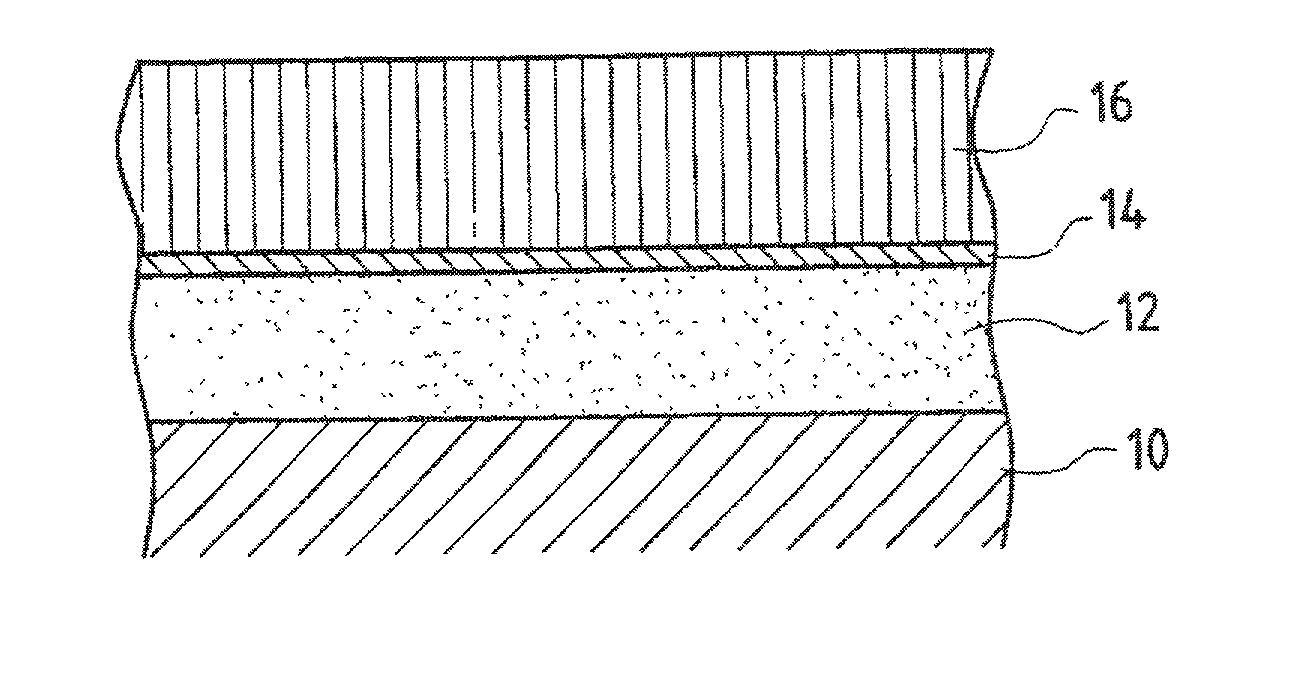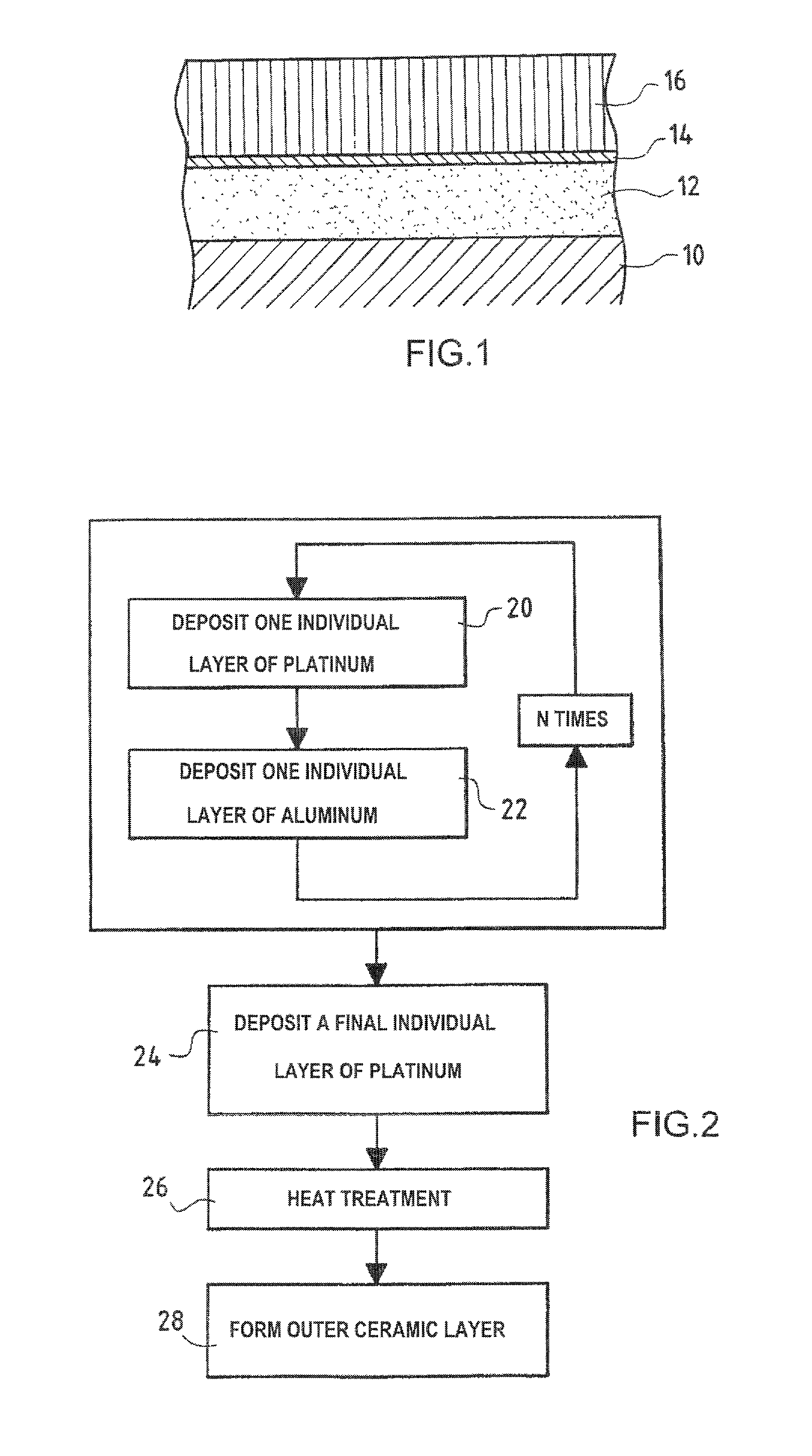Method of making a protective coating forming a thermal barrier with a bonding underlayer on a superalloy substrate, and a part obtained thereby
a technology of superalloy and thermal barrier, which is applied in the direction of vacuum evaporation coating, liquid fuel engine components, chemical vapor deposition coating, etc., can solve the problems of easy deterioration of the thermal barrier, difficult control of the precise composition of the bonding underlayer, etc., and achieve the effect of small thickness
- Summary
- Abstract
- Description
- Claims
- Application Information
AI Technical Summary
Benefits of technology
Problems solved by technology
Method used
Image
Examples
example 1
[0075] A nickel-based superalloy metal substrate for a high pressure turbine blade of a turbojet engine was provided with a bonding underlayer made of an intermetallic compound, as follows:
[0076] Five individual layers of platinum each having a thickness of about 500 nm were deposited in alternation with four individual layers of aluminum each having a thickness of about 1330 nm The individual layers were formed by cathode sputtering under the conditions described with reference to FIG. 3.
[0077] FIG. 4 shows the individual platinum layers (pale color) and the individual aluminum layers (dark color) as obtained after deposition.
[0078] Heat treatment was then performed in an inert atmosphere (argon) at a temperature of 700.degree. C. for a period of 2 h. A bonding underlayer having a total thickness equal to about 7.8 .mu.m was obtained and it comprised an intermetallic compound of the PtAl.sub.2 type.
[0079] FIG. 5 is a section through the structure of the bonding underlayer. It can b...
example 2
[0082] (for comparison)
[0083] A bonding underlayer having substantially the same total thickness and the same composition as that of Example 1 was formed on a substrate of the same kind as that used in Example 1 and under analogous conditions, except that it was made by depositing three individual layers of platinum each having a thickness of 833 nm in alternation with two individual layers of aluminum each having a thickness of 2650 nm. Adhesion testing performed under the same conditions as in Example 1 revealed poor adhesion to the substrate. In addition, the outer surface of the underlayer presented defects (depressions) revealing localized melting of the aluminum.
example 3
[0084] A nickel-based superalloy metal substrate for a high pressure turbine blade of a turbojet engine was provided with an intermetallic thermal barrier underlayer as follows:
[0085] Two individual layers of platinum each having a thickness equal to about 1150 nm were deposited on the substrate together with an intermediate layer of aluminum having a thickness of about 1400 nm. The layers were formed by cathode sputtering.
[0086] Heat treatment was then performed in an inert atmosphere (argon) at 700.degree. C. for a period of 2 h. The platinum and aluminum layers then reacted exothermally to form an intermetallic compound Pt.sub.5Al.sub.3. The underlayer having a total thickness of about 3.7 .mu.m retained a laminated structure.
[0087] Analysis performed as in Example 1 showed that the underlayer was made up only of the elements supplied (aluminum and platinum) and did not include any traces of elements from the substrate.
PUM
| Property | Measurement | Unit |
|---|---|---|
| Thickness | aaaaa | aaaaa |
| Thickness | aaaaa | aaaaa |
| Thickness | aaaaa | aaaaa |
Abstract
Description
Claims
Application Information
 Login to View More
Login to View More - R&D
- Intellectual Property
- Life Sciences
- Materials
- Tech Scout
- Unparalleled Data Quality
- Higher Quality Content
- 60% Fewer Hallucinations
Browse by: Latest US Patents, China's latest patents, Technical Efficacy Thesaurus, Application Domain, Technology Topic, Popular Technical Reports.
© 2025 PatSnap. All rights reserved.Legal|Privacy policy|Modern Slavery Act Transparency Statement|Sitemap|About US| Contact US: help@patsnap.com



